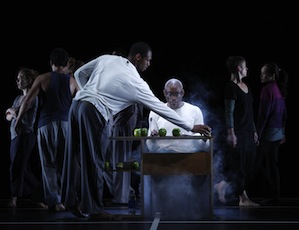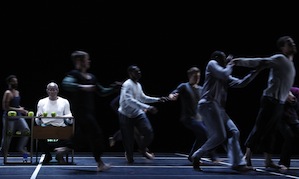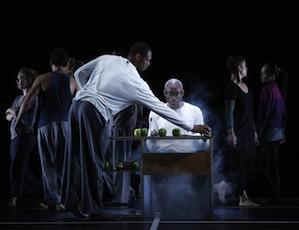
Bill T. Jones began Story/Time on Saturday night with an audience-participation exercise, asking those gathered in Zellerbach Hall to raise their hands when a minute had passed by. Some people came close and some didn’t. If there’s anything to be drawn from the variations in inner clocks, maybe it’s just that those differences in perception of time can extend to differences in other perceptions as well. It was an ingratiating beginning to Story/Time, master choreographer and performing artist Jones’ debut as a non-dancer — at least with his own Bill T. Jones/Arnie Zane Dance Company.
Jones sits center stage at a table and reads 70 one-minute stories, randomly chosen from around 170 he’s written, while his dancers accompany him and the music. The inspiration is John Cage’s Indeterminacy, and the music is an intriguing chance-driven mashup from folk, electronic, classic, spoken word, and other sounds, all strung together by Ted Coffey, who studied with a Cage acolyte. The movement phrases are drawn from 35 or so creations of Jones and his dancers, who along with his associate artistic director Janet Wong, are credited with assisting in the choreography.
It would sound strange and mean little or nothing to retell these stories. Nowhere is “You had to be there” more fitting, and yet, in the telling, none are obscure, abstruse, or boring. One has to attribute this to the entire matrix of the performance, the liason of dance, speech, music, scenery, although the elements all, in time-honored chance fashion, seem disconnected from each other.

Some of Jones’ mini-sagas are deeply personal, dealing with love, sex, family. Some are funny; others offer glimpses of fame, disaster, bigotry, poverty. None seem truncated, though Jones delivers a few in slow-drawn fashion, as if to wait out the digital shot clock on the wall. And many of the stories are so distracting — is it the way Jones speaks, or how the music surges, or how the lights (designed by Robert Wierzel) blaze in a smoky haze? — that we have trouble focusing on the dancers. On the other hand, sometimes what the dancers are doing makes it impossible to listen to Jones, but, I would say, less often.
It was easier to focus in bygone years, when Jones was talking, then dancing, then talking, or pausing to rip into a movement phrase — and the man could rip — before saying something else. There was one place to look, even when there were other dancers on the stage. Now we look and listen in a less concentrated fashion. Not unrewardingly, mind you. This is a strong and often splendid company of nine. They have Jones’ own style and intensity, albeit, to these eyes, their centers of gravity are higher in their bodies than his was. They have gorgeous extensions and lightning feet, and the bravery to fling themselves horizontally into their colleague’s arms, or, for some, to be briefly naked, bodies gleaming dimly in light spill, inching along the floor as Jones reads about Noah and the flood.
They’re a close team, these young virtuosos in soft and colorful casual clothes, which makes some of what they do look deceptively easy. It’s hard to remember that they must remember the order in which the phrases they’re doing will appear, and where they have to be.
It all went by so fast and so well: 70 minutes, 70 stories, 70 slices of dance, sound and life. As with the measuring of the first minute, how it counted was up to you.

